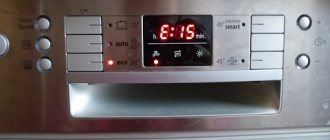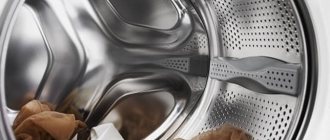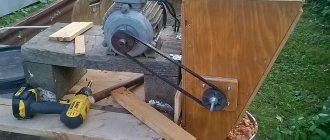A dishwasher helps housewives quickly complete household chores and leave free time to do other things. But sometimes it happens that a household appliance fails for a number of reasons. You can understand that the dishwasher has stopped coping with its duties by the quality of the washed dishes and other visible signs: leaks, overheating of the appliance and other indicators. If characteristic malfunctions are detected, it is strictly forbidden to turn on the machine and run the dishwashing program. The main thing is to repair the dishwasher in a timely manner, then it will be possible to avoid more serious consequences and complete failure of the machine. Most problems are quite easy to fix on your own; you don’t even need to call a technician.
Dishwasher structure and operating principle
When planning to repair a dishwasher with your own hands, you must accurately understand its design, the purpose of all components and the general principle of operation. The optimal configuration and configuration of this type of equipment has been around for quite some time. Almost all well-known manufacturers use them, adding only minor design changes and special modes for processing dishes.
The dishwasher is an indispensable assistant for the housewife in the kitchen.
In general, a dishwasher is a fairly spacious cabinet, inside of which there are special baskets for storing dirty dishes. Washing occurs due to jets of hot water hitting from all sides, to which surfactants can be added to increase efficiency.
For information! Modern technology uses a minimal amount of water due to its repeated circulation and filtration.
The water circuit includes:
- a volumetric tank, usually located under the washing chamber;
- receiving pipeline connected to the cold water supply system;
- shut-off valve with a water level sensor in the tank, responsible for the presence of the required amount of liquid during operation;
- circulation pump;
- a small container for powder or cleaning solutions;
- filters for coarse and fine water purification;
- nozzles and rotating sprinklers of various designs;
- pump for pumping out dirty wastewater, connected by a hose to the sewerage system.
In the dishwasher, appliances are treated with jets of hot water
Powerful heating elements are responsible for heating the water. The entire process is controlled by a control unit with pre-selected standard dish processing programs. Main modes:
- pre-wash;
- main wash;
- rinsing with clean water;
- drying.
The drying process can occur in two ways:
- Natural evaporation of liquid. To speed it up, the final rinse is done with hot water.
- Turbo drying using a fan that blows water vapor out of the chamber.
The principle of condensation drying in a dishwasher
Some secrets
A productive DIY repair of a Bosch dishwasher using a video can be done even when troubleshooting problems of moderate complexity. Malfunctions include the power button sticking and the door breaking, which is difficult to open. In this situation, you will have to use the tips and remove the front or side panels.
If the device is used intensively, the door lock that secures it often fails. To replace it, you need to disassemble the front panel of the device. Sometimes the breakdown lies in the jamming of the power button. In this situation, you will need to remove dirt from the groove where the button is installed. If the problem persists, the button should be replaced.
It is quite possible to restore the functioning of equipment manufactured by this well-known brand without the participation of specialists. The main thing is to take into account the features of the device and strictly follow the recommendations of the operating manual.
Are you ready to repair your dishwasher yourself after the warranty period expires? This question is not at all from the realm of science fiction - in order to restore the functionality of a dishwasher (hereinafter also referred to as a dishwasher, PMM), you do not need to have high engineering qualifications. It is enough to know how to handle a tool and a simple testing device - a multimeter.
Repairing household appliances yourself will save you money and time. And if the attempt is unsuccessful, then call a specialist to your home.
Causes of malfunctions
There are many factors that can cause any dishwasher to malfunction. The main ones:
- Natural wear and tear of parts that have exhausted their service life.
- Poor quality assembly or the use of defective materials, which is typical for cheap models from dubious manufacturers.
- Careless handling.
- Malfunction of the plug, socket or other elements of the external electrical network.
- Incorrect hose connections causing excessive tension or vibration.
- Regular entry of large pieces of food into the washing chamber with dirty dishes.
- Using detergents not recommended by the machine manufacturer.
- Incorrect loading of dishes.
- The spring is loose or the door latch mechanism is dirty.
Be careful! Sometimes simply sloppy closing of the loading hatch prevents the machine from starting.
The car is full of dirty water
The presence of a large amount of dirty water in the dishwasher clearly indicates a problem. The situation is clear: the drain does not function correctly, which is why the waste liquid does not leave the chamber, but remains inside. The problem is resolved quite simply.
We diagnose the drain pump. First, we clear the debris and measure the number of ohms in the winding
Often the drain is blocked by low pressure. If the pump has not failed, pay attention to the drain hose and siphon. The resulting blockage prevents waste water from exiting
Therefore, we disconnect the components and rinse thoroughly under the tap.
In some cases, repairs are not needed at all. When the hose is raised above the level specified in the factory instructions, the dishwasher cannot drain the water because there is not enough pressure and pressure. Sometimes weak fastenings or squeezing of pipes fail.
Dishwasher breakdowns and how to fix them
Since the reasons for the breakdown of your dishwasher can be different, the methods for eliminating them must be applied in accordance with the specific situation.
You can fix many dishwasher problems yourself.
The washing process does not start
You have loaded the dishes and turned on the wash cycle. All indications are displayed in the usual way, the characteristic sound of filling the tank with water is heard, but its circulation does not begin. There are several options to check:
- The filter installed at the outlet of the pan at the bottom of the chamber is clogged. It must be removed, washed with a stream of water and replaced.
- Injector nozzles are dirty. You can often fix this problem by cleaning the holes with a regular toothpick.
- Failure of the circulation pump. The repair will consist of replacing it with a similar unit. If you are not confident in your ability to correctly install the pump and connect the motor to the electrical circuit, contact a specialist. Sometimes the cause of failure is a broken electrical circuit. In this case, the technician needs to ring the circuit and check the motor winding for an interturn short circuit.
Clue! A malfunction of the circulation pump may be indicated by the absence of a characteristic sound that always occurs during normal operation.
The water is overflowing
The reasons for the continuous flow of fresh water into the tank may be:
- breakdown of the level sensor located in the tank;
- Faulty solenoid valve on the filling line.
In both cases, you will need to open the dishwasher body and replace the defective device with a new one.
Overheating or underheating of water
The cause of excessive heating of water, accompanied by the formation of a large amount of steam, can only be incorrect operation of the temperature sensor. It will have to be replaced.
In case of low heating, the following options are possible:
- sensor failure;
- heating element failure.
The heating element is checked with a multimeter and replaced if a malfunction is confirmed.
Doesn't drain
The lack of pumping of dirty water into the sewer can be explained by a breakdown of the corresponding pump or a blockage. Contaminants are combated by disassembling the butt joints of the drain hose, siphon and sewer pipe, followed by mechanical cleaning and rinsing with plenty of water. If the pump fails, it will have to be replaced.
On a note! Sometimes incomplete pumping of waste water may be due to an unreasonably high location of the drain hose. By securing it lower, you can easily get rid of such a nuisance.
The body is electrocuted
Electric shocks indicate a short circuit of live parts to the device body. This means that the electrical circuit of the dishwasher has broken down. The most likely reason for this is a breakdown of the heating element shell. To verify this, it is enough to remove it from the socket and carry out an external inspection.
If your dishwasher is electrocuted, the heating element is broken.
If cracks or other defects are detected, immediately change the heating element.
Doesn't pick up detergent
If you find that the powder or tablet with detergent after washing the dishes is not completely dissolved, then this is due to three reasons:
- insufficient pressure of incoming water;
- clogged receiving filter (for models equipped with it);
- solenoid valve malfunction.
Make sure the water supply system is working properly, wash the filter to remove rust and other mechanical deposits, replace the valve if the first two steps do not lead to success.
Lack of power
The lack of power can be judged by the non-functioning indication on the control panel and the machine ignoring your pressing of the start button. In this case, you should check the possible problems one by one:
- there is no reliable contact inside the socket or the machine at the entrance to the apartment has tripped;
- The network filter has failed;
- breakdown of the start button mechanism;
- the loading door is not tightly closed;
- the lock burned out.
Problems with the cord - a possible dishwasher malfunction
The defective device is found using a multimeter and careful inspection. The nature of the repair is determined by the degree of damage to the parts.
Extraneous noise
Increased noise is always associated with improper operation of rotating parts. First of all, check to see if a foreign object has entered the sprayer's coverage area. If this is not the case, then there is a high probability of destruction of the pump or electric motor bearings. This happens when water leaks through a weakened seal. There are two repair options:
- Replace the oil seal and defective bearing.
- Purchase and install a new pump.
The first of them is labor-intensive, the second is more expensive.
Dishes won't dry
The problem with poor drying of dishes is always associated with a broken fan. This can be determined by ringing it with a tester. Usually it cannot be repaired, but simply replaced with a new one.
Water leaking on the floor
The appearance of water flowing from the bottom of a household appliance requires immediately unplugging it from the outlet and searching for the reason why your dishwasher is leaking.
If the dishwasher is not level, water overflows
Most likely, the culprits of the flood will be:
- Elastic door seals. Dirt may stick to them. They often fray or tear. They can be easily cleaned or replaced.
- Pump seals or loose clamps at hose connections. They are replaced or tightened until the leak is eliminated.
- Defective water tank. It is usually not repaired, but replaced with a new one.
To begin repairing a current dishwasher with your own hands, you need to accurately determine the location of the leak. To do this, lay dry newspapers and follow the appearance of wet spots.
Attention! Sometimes leaks occur due to excessive foam formation. Check whether the detergent you are using is correct.
Unexpected machine shutdown
If the machine turns off during operation, the reason for this may be:
- external problems associated with voltage fluctuations in the network or the operation of a circuit breaker in the electrical panel;
- internal damage to the electrical circuit, which includes the activation of the lock and failure of the control unit. An experienced technician should be involved in their repair.
If your dishwasher is faulty, do not delay repairs.
Foam does not wash off after washing
The presence of foam in the chamber after washing is completed indicates a failure in the settings of the control unit or incorrect use of the detergent. Some models do not recognize 3-in-1 tablets, and they do not have time to completely dissolve before the end of the full processing cycle. Re-read the operating instructions and act in accordance with their recommendations.
Advice! Often, a clogged filter prevents proper circulation and replacement of solutions. It should be repaired and cleaned regularly.
What to do if the dishwasher is still under warranty
For at least the first year after purchase, do not repair it yourself - by doing so, you will deprive yourself of warranty benefits. The warranty period and conditions must be clarified when purchasing household appliances.
During this period, you can work to remove blockages in the dishwasher filters. In addition, it is allowed to clean the holes in the sprinkler rocker arms from dirt and food debris if the PMM begins to wash dishes poorly.
Do not forget that many defects in work occur due to non-compliance with operating rules. The machine may not work only because there is no water in the water supply or someone has closed the inlet ball valve.
Therefore, you need to periodically check: the presence of electricity in the sockets, the water pressure in the water supply and the absence of blockages in the sewer. If you connect the dishwasher to the communications yourself, make sure you did everything correctly. An error may result in the PMM refusing to wash dishes.
Remember: you do not need to take the PMM yourself for repairs to a service center under warranty. This must be done by the store that sold you this equipment, because it weighs more than 5 kg. It is quite possible that technicians will volunteer to repair the device at home.
Electronic prompts about the type of failure
Modern models are equipped with an internal self-diagnosis system. It controls the operation of most critical units, constantly comparing it with the nominal parameters. If a fault is detected, the machine stops and an error code appears on the display. All of them are present in the product instruction manual.
Find a table with recommendations for troubleshooting common problems. They are the ones who will show you the right path to how to repair a stopped dishwasher yourself.
Watch a video about the main causes of dishwasher failure
What breaks most often?
A professional technician will point out the causes of the failure and help eliminate it. However, some problems are completely do-it-yourself, since they can be effectively solved at home. Using the instruction manual for a particular Bosch dishwasher model, it is quite possible to solve problems on your own when:
- no food;
- the unit has stopped removing water;
- the water is not heated;
- The device does not turn on.
It is quite possible to repair a Bosch dishwasher yourself if an error is constantly displayed on the equipment display. It is easy to solve the problem of the inability to collect water. Another common malfunction is the inability to open or close the appliance door.
Bosch dishwasher repair
Problem 2: Water has flooded the bottom of the machine or is leaking
If water has flooded the bottom, then repairs are not required in this case - in most cases, the cause of this is clogged filters.
Filters are located in the bottom area - in the place where the drain takes place. They are easy to get, no instructions are needed here. It is advisable to clean them before each start of the machine.
It is normal for a small amount of clean water to accumulate around the compartment outlet at the rear of the compartment. This way the seals remain wet.
If water or foam is leaking, it is most likely due to an overfilled dispenser or spilled rinse aid causing foam to form.
The resulting puddle just needs to be wiped away and next time do not overfill the dispenser. In other cases, the problem may be wear/damage to gaskets or pipes.











